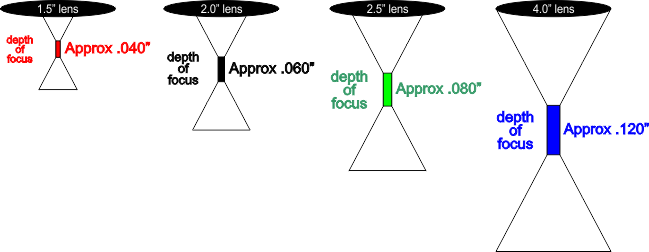The mysteries of focus unraveled here…
Why do you need different lenses?
When do you need a rotary indexer?
Learn the differences and understand the trade off’s of laser lenses
What laser do you have – Flatbed or Galvo?
CO2 Flatbed Focus Lenses –
Below are examples of different lenses using typical lenses found in a flatbed laser system.
Below is information about different lenses and how far a laser can mark around an arbitrary round part with each lens:

Below you can see lenses have different focal ranges in terms of length and depth. Beam width also changes, effecting resolution and beam energy. Energy is lost in a logarithmic fashion because the circumference of a circle is 3.14 (pi). Spot size times pi is the energy of the spot and is why higher wattage is necessary when using larger lenses, especially using the 4″ lens. This is also why a 30 watt CO2 laser using a 2.5″ lens has a hard time cutting through even .25″ wood or acrylic.

Below is the approximate spot size of each laser lens. The lens acts as a magnifying glass and converges the beam of light. The point at the sharpest convergence is the “spot size” and where laser processing takes place. There are always trade offs between lenses. Using a larger lens with larger spot could mean using lower DPI and finsihing the the job faster; however, if you are looking for details, either vector cutting or raster engraving, then you may find that the smaller lens with finer resolution is better at the cost of using higher DPI.

Fiber Galvo Focus Lenses –
Lens Sizes:
The lens in a galvo style laser dictates the size of the process field. The fast moving mirrors move the laser beam in the X and Y directions.
As with the flatbed, there are trade offs of using one lens over another lens.
The information below relates to fiber lasers. CO2 lasers are also galvo based and use a different set of lenses.
| 100 mm lens Approx 2″ process field |
160 mm lens Approx 4.5″ process field |
254 mm lens Approx 7.5″ process field |
330 mm lens Approx 9.5″ process field |
420 mm lens Approx 12″ process field |
|---|---|---|---|---|
 |
 |
 |
 |
 |
| 100mm
Beam is the |
160mm
Best all around for marking |
254mm
Larger lens is better for marking many plastics, since plastics have a low melting point. Deep engraving is Ok using a 50 watt pulsed fiber laser or higher. 10 and 20 and 30 watt pulsed fiber lasers may not overcome reflectivity of some shiny metals Good lens for marking surgical tools that need to survive passivation |
330mm
Deep engraving using higher powered pulsed fiber lasers. Good lens for marking surgical tools that need to survive passivation Good for marking plastics Good for marking anodzied aluminum |
420mm
Good for marking anodzied aluminum Good for marking plastics Best focus range |
| Focus Range 100mm | Focus Range 160mm | Focus Range 254mm | Focus Range 330mm | Focus Range 420mm |
| .020″ (.5mm) | .080″ (2mm) | .240″ (6mm) | .43″ (11mm) | .64″ (16mm) |
Different galvo lens types:
F-theta lens is more expensive because it is machined such that the beam will attempt to be perpendicular to the work piece. and focus is virtually the same across the entire process field. It doesnt quite get there, but for non-critical tolerances, the actual “laser mark” position and focus point are far more predictable
Non-F-theta lens is less expensive and the beam is similar to a pendulum when it exits the lens and therefore change in focus away from field center should be expected. Also, the laser mark location will appear to be offset due to the different focus points.



